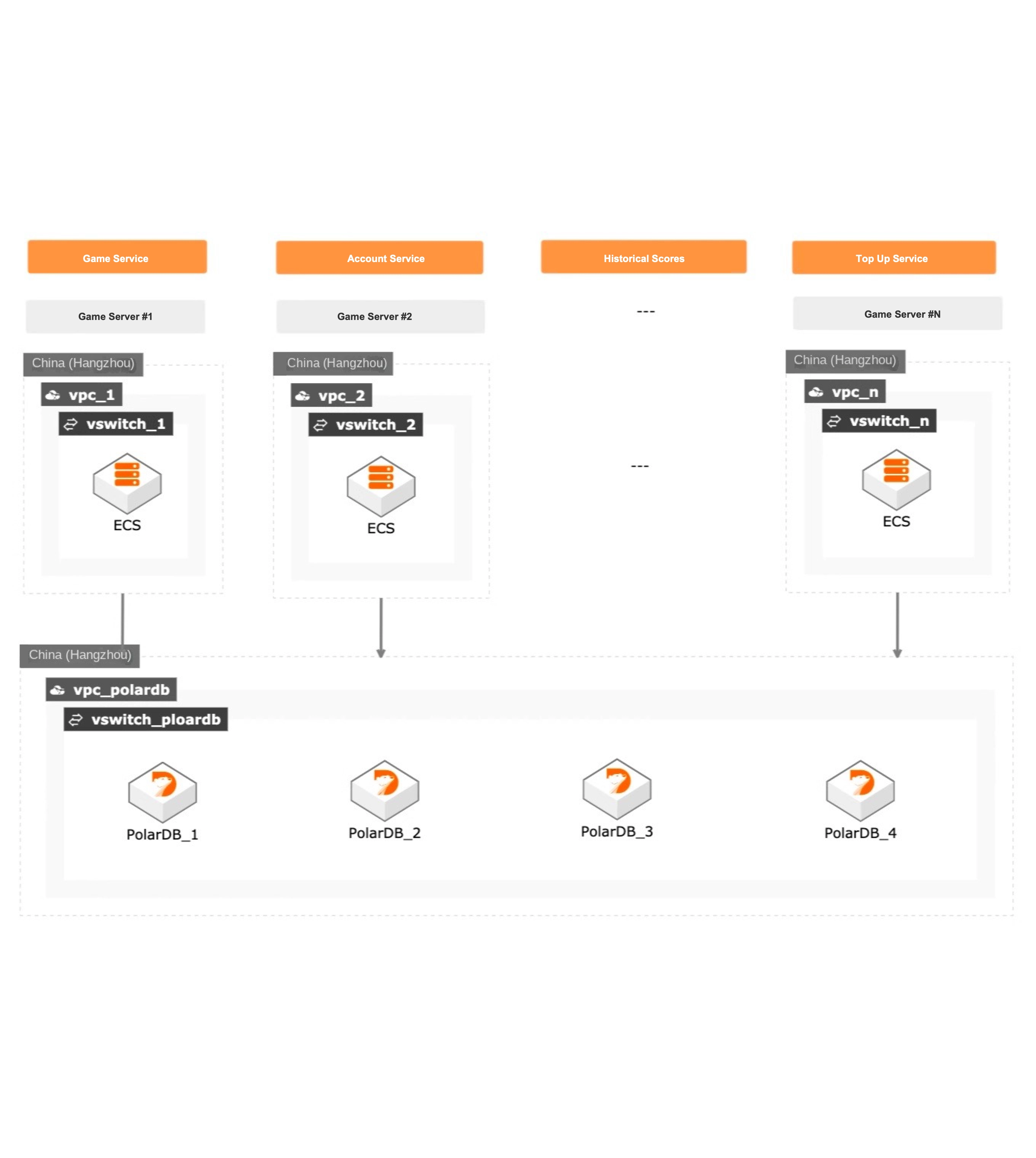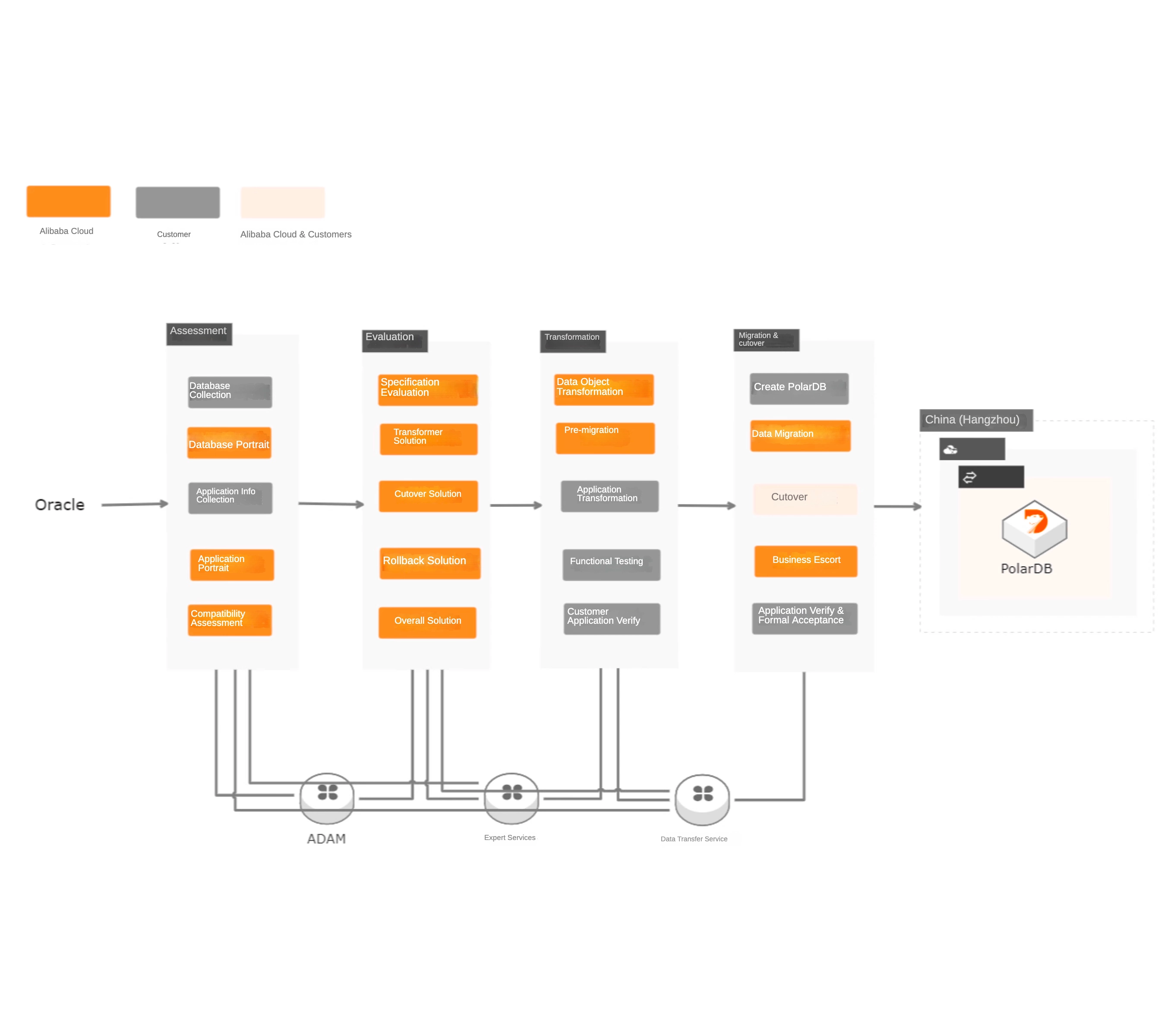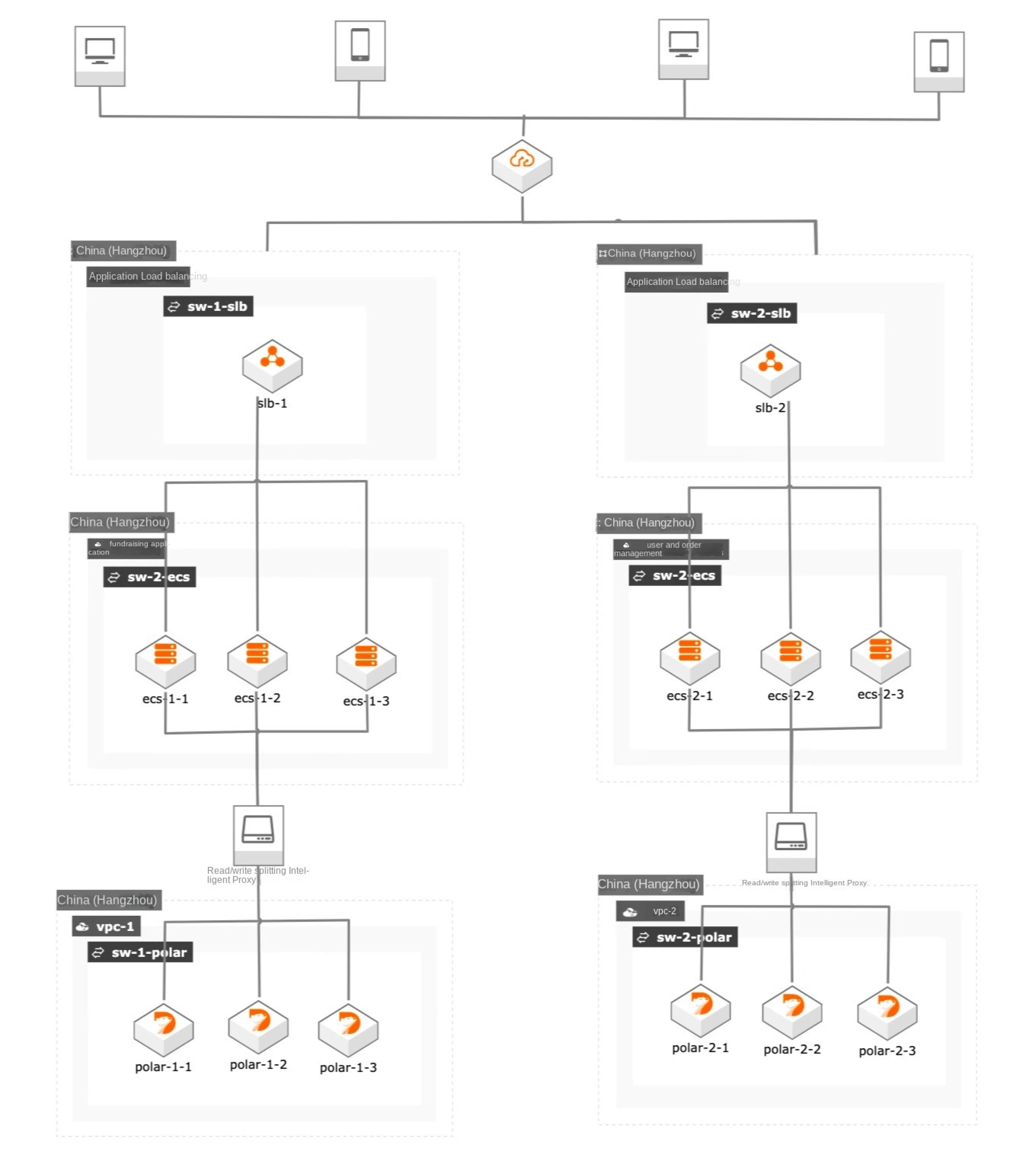
Documentation >
Console >

Documentation >
Console >

Documentation >
Console >
PolarDB is designed for business-critical database applications that require fast performance, high concurrency, and automatic scaling. You can scale up the node specification and scale out the number of nodes in a cluster to provide a PolarDB cluster that has millions of QPS and up to 500 TB of storage.
PolarDB provides three editions with different engines: PolarDB for MySQL, PolarDB for PostgreSQL, and PolarDB for Xscale.
Always Free PolarDB Instance
We are introducing an Always Free PolarDB campaign for all variations to support the developer community. After successful participation, one resource of the specified specification can be used for free. Regional resource availability is subject to change. When resources are unavailable in certain regions, you can switch your free tier instance to a different region or to a paid plan in any specific region. Please read the Terms & Conditions for more information.
See Guide > to learn how to get started.
Free
PolarDB for MySQL
Each user can participate once a month and is allowed to launch one PolarDB instance for free each time.
Specifications of the free PolarDB instance
-
Node Specification: 2C8G (General-Purpose)
-
Storage Capacity: 50 GB
Available Regions
China (Hong Kong) | Germany (Frankfurt) | Indonesia (Jakarta) | Japan (Tokyo) | Singapore | Thailand (Bangkok) | UK (London)
Free
PolarDB for PostgreSQL
Each user can participate once a month and is allowed to launch one instance for free each time.
Specifications of the free PolarDB instance
-
Node Specification: 2C8G (Dedicated)
-
Storage Capacity: 50 GB
Available Regions
China (Hong Kong) | Germany (Frankfurt) | Indonesia (Jakarta) | Japan (Tokyo) | Singapore | Thailand (Bangkok) | UK (London)
Engine Selection Guide
| Item | PolarDB for MySQL | PolarDB for PostgreSQL | PolarDB for Xscale |
|---|---|---|---|
| Database Ecosystem | MySQL | PostgreSQL and Oracle | MySQL |
| Architecture | A shared-storage architecture in which computing and storage resources are decoupled | A shared-storage architecture in which computing and storage resources are decoupled | A distributed share-nothing architecture |
| Scenario | Build cloud-native applications based on MySQL | Build cloud-native applications based on PostgreSQL or migrate traditional commercial databases to the cloud | Build MySQL-based applications that require ultra-high concurrency |
Benefits

Compatibility with MySQL and PostgreSQL Ecosystems
PolarDB is 100% compatible with the ecosystems of MySQL and PostgreSQL. Your applications or services can connect to and use PolarDB without modifications. You can migrate your databases from an ApsaraDB RDS for MySQL High-Availability Edition instance to a PolarDB cluster with the endpoints of your databases unchanged. PolarDB is highly compatible with the Oracle syntax. You can use the tools provided by ADAM to migrate your data from Oracle. This way, the costs and the time required for migration can be reduced by at least 90%.

Massive Storage and High Scalability
A PolarDB for MySQL or PolarDB for PostgreSQL cluster supports a maximum of 500 TB of storage. You can configure up to 16 nodes for a PolarDB for MySQL or PolarDB for PostgreSQL cluster. Each node supports up to 88 vCPUs. The storage of PolarDB for MySQL and PolarDB for PostgreSQL is built based on distributed Serverless architecture and can automatically scale up or down based on the data volume. The storage capacity of PolarDB for Xscale clusters can be scaled out to petabytes of data.

Cost-Effectiveness
PolarDB can execute operations more than 100 times faster than traditional MySQL and PostgreSQL databases. All compute nodes within a PolarDB cluster shares the storage of the cluster. When you scale out a cluster, you only need to pay for the read-only nodes you want to add to the cluster, which significantly reduces the scale-out costs. The storage capacity of PolarDB is automatically extended as the volume of your data grows. You only pay for the actual storage capacity used.

High Availability That Ensures Business Continuity
PolarDB can switch over services from the primary node to a secondary node with no data loss when the primary node fails. This resolves the issue of data inconsistency between the primary and secondary nodes caused by asynchronous replication. You only need to take a few minutes to add read-only nodes, back up data, and restore data. PolarDB can be deployed in different modes to implement different disaster recovery capabilities. For example, you can deploy PolarDB in three data centers within the same region or five data centers across three different regions.
Flexible billing methods to meet different cost requirements
PolarDB for MySQL supports pay-as-you-go and subscription billing methods.
Pay-As-You-Go
The pay-as-you-go billing method is used to deduct fees from your Alibaba Cloud account balance based on the specifications of the compute instances or the actual storage usage when the order is generated. This billing method applies to scenarios when the instances are used for a short period or only small amounts of data are involved. The compute instances can be automatically scaled up or down during use and can be released as soon as they are used up.
Subscription
The subscription billing method requires you to pay fees for compute instances or storage before you can use them. This billing method applies to scenarios when the instances are used for a long period or large amounts of data are involved. This billing method is more cost-effective than pay-as-you-go. A subscription compute plan with a longer validity period or a subscription storage plan with a larger capacity is more cost-effective.
Enterprise-class capabilities for various business requirements
PolarDB for MySQL provides various enterprise-class capabilities, including automatic backup, one-click restoration, Global Database Network (GDN), parallel queries, and fast DDL operations. The read and write capabilities of PolarDB for MySQL clusters can be expanded within minutes.
Elastic Scaling
PolarDB for MySQL supports the following three types of scaling: vertical scaling of computing capacity (the upgrade or downgrade of cluster specifications), horizontal scaling of computing capacity (the adding or removing of read-only nodes. A maximum of 16 computing nodes can be added), and the horizontal scaling of storage capacity (the automatic scaling of storage capacity based on data volume changes. The maximum storage capacity for a single instance is 500 TB). The specification changes of your cluster take effect within a few minutes.
Backup and Restoration
PolarDB for MySQL supports custom backup policies and the following three backup types: Level-1 backups are stored on a distributed storage cluster and are fast to restore. Level-2 backups are level-1 backups that are compressed and stored in on-premises storage. Level-2 backups require a longer time to restore. Log backups are redo logs uploaded to OSS in parallel in real-time. You can back up a PolarDB for MySQL database that stores 1 TB of data within ten seconds and restore the data sets within ten minutes.
GDN
A global database network (GDN) consists of multiple PolarDB clusters distributed across regions worldwide. Data in the clusters within a GDN are synchronized by using technologies such as asynchronous replication, physical logs, and parallel processing. It takes less than two seconds to replicate data between two PolarDB clusters with the same specification in different regions. PolarDB clusters in a GDN support cross-region read/write splitting, data reading from nearby clusters, and flexible configurations.
Parallel Queries
PolarDB for MySQL 8.0 supports parallel queries by distributing data to different threads at the storage layer. Multiple threads perform parallel computing and return the results to the leader thread. This way, the time required to respond to complex SQL queries and report queries can be significantly reduced. For example, if 100 GB of data is stored in a PolarDB for MySQL 8.0 cluster that has 88 CPU cores and 710 GB of memory, the response speed of the cluster to queries can be increased up to 30 times after parallel queries are enabled for the primary node.
Fast DDL Operations
PolarDB for MySQL supports DDL physical replication optimization. This feature optimizes the key paths of writing redo logs on the primary node and using redo logs on read-only logs. This way, you can instantly add columns to a table or add indexes in parallel. For example, if 1 TB of data is stored in a PolarDB for MySQL 8.0 cluster that has 16 CPU cores and 128 GB of memory, it only takes one second to add a column to a table in the cluster, which is ten times faster than open-source MySQL databases.
IMCI
The IMCI feature can be used with the parallel vectorized execution engine for column store data to significantly improve the execution efficiency of complex queries. This way, PolarDB for MySQL implements integrated real-time transaction processing and data analysis features and provides a one-stop hybrid transaction/analytical processing (HTAP) solution. PolarDB for MySQL allows you to use one system to meet the requirements in both OLTP and OLAP scenarios.
Extensive O&M features to significantly reduce O&M costs
PolarDB for MySQL provides O&M features to implement 24/7 anomaly detection based on machine learning and fine-grained data monitoring. This way, the stability, security, and efficiency of your databases can be ensured.
Diagnostics
PolarDB for MySQL provides a variety of diagnosis features for you to view the diagnostics and optimization results of databases. These features include the autonomy center, session management, real-time monitoring, storage analysis, deadlock analysis, diagnostic reports, and performance insight.
Monitoring and Alerting
PolarDB for MySQL allows you to monitor a variety of performance metrics and view monitoring data at intervals of seconds. This way, you can detect and solve the exceptions that occur on your PolarDB clusters or nodes based on the monitoring data.
SQL Explorer
SQL Explorer collects all SQL statements executed on databases in real-time and uses powerful analytic and query engines to identify potential performance or security risks. Logs of the SQL statements are retained up for to five years.
Slow SQL Queries
PolarDB for MySQL provides the slow SQL query analysis feature. This feature allows you to view slow log trends and statistics. You can also obtain diagnostic results and suggestions on how to fix slow SQL queries.
Auto Scaling
You can configure the threshold, the specification of nodes, and the number of read-only nodes for auto scaling. If the average CPU utilization is greater than or equal to the specified threshold, automatic scale-up is triggered.
Compatibility with Oracle for ease of use
PolarDB for PostgreSQL is highly compatible with the Oracle syntax and supports professional migration assessment tools provided by ADAM. This way, you can migrate your data in Oracle databases to PolarDB PostgreSQL.
High Compatibility with the Oracle Syntax
PolarDB for PostgreSQL supports all native interfaces of Oracle and almost all database objects in Oracle. PolarDB for PostgreSQL is highly compatible with the Oracle syntax and some key features (such as DBLINK, partitioned tables, and PL/SQL). PolarDB for PostgreSQL uses similar logical concepts to Oracle, including users, roles, modes, and permissions. In addition, PolarDB for PostgreSQL uses a share-everything storage architecture that uses the same file system structure and ACID concepts as Oracle.
Free Migration Assessment
You can use ADAM to assess the migration of databases and applications, transform databases online, and access applications free of charge. ADAM can assess the compatibility, association, performance, risks, and required modification methods of databases and applications and provide suggestions on how to resolve compatibility issues and how to optimize and convert database engines.
Database Expert Service
PolarDB for PostgreSQL provides the database expert service with tools to help enterprises implement Oracle features with low costs. The service covers operations within the entire migration process, including schema migration, data migration, consistency verification, and the simulation, playback, cutover, and optimization of SQL statements.
Compute-storage decoupled architecture that exploits the advantages of cloud-native databases
PolarDB for PostgreSQL is designed based on a cloud-native architecture in which storage and computing resources are decoupled. You can scale up the read and write capabilities of PolarDB for PostgreSQL within minutes and configure up to 16 compute nodes for a PolarDB for PostgreSQL cluster.
Elastic Scaling
PolarDB for PostgreSQL supports the elastic scaling of a cluster within minutes. You can scale the compute capabilities of a cluster up or down by changing the specification of each compute node within the cluster or changing the number of read-only nodes (16 compute nodes maximum) within the cluster. You can also scale up the storage capacity of a cluster by adding storage nodes.
Large Storage Capacity
PolarDB for PostgreSQL uses shared storage whose capacity is automatically adjusted online based on the data volume. A single PolarDB for PostgreSQL cluster provides up to 100 TB of storage. The storage of a cluster is shared by all compute nodes within the cluster. This way, no additional storage costs are incurred when you add compute nodes.
High Availability
PolarDB for PostgreSQL uses distributed shared storage and physically replicates data. This way, the latency caused by logical data replication is avoided and the global consistency of data can be ensured.
Managed PostgreSQL databases that reduce costs
PolarDB for PostgreSQL provides a fully-managed database service to improve productivity and reduce the total cost of ownership (TCO).
Ease of Use
PolarDB for PostgreSQL is fully compatible with PostgreSQL.
Version Upgrade
PolarDB for PostgreSQL allows you to manually upgate the minor engine version to improve performance, introduce new features, or fix known issues.
SQL Explorer
SQL Explorer collects all SQL statements executed on databases in real time and uses powerful analytic and query engines to identify potential performance or security risks.
Efficient storage and computing capabilities for large amounts of spatio-temporal data
PolarDB for PostgreSQL is integrated with GanosBase, the spatio-temporal data engine developed by DAMO Academy. You can use PolarDB for PostgreSQL to store, manage, index, and process spatio-temporal data.
Support for All Spatial Data
PolarDB for PostgreSQL supports various types of data, including vectors, grids, trajectories, point clouds, meshes, paths, 3D surface models, and 3D body models. Therefore, you can use PolarDB for PostgreSQL to store and process all spatial data in a unified manner, including data indoors and outdoors, data above and below ground, dynamic and static data, and digital twin data.
High Performance
PolarDB for PostgreSQL allows you to create multi-level parallel spatio-temporal operators to push down computing operations for higher computing efficiency.
Compatibility with Spatial Data and Services
PolarDB for PostgreSQL is compatible with various types of commercial or open-source spatial data and services. You can use the spatial data system based on GIS to build a city-level spatial data warehouse that applies to multiple platforms.
Integrated Distributed
PolarDB for Xscale Standard Edition
PolarDB for Xscale is fully compatible with MySQL and uses the Paxos-based multi-replica architecture that includes a primary node, a secondary node, and a log node. PolarDB for Xscale has a wide range of specifications and is cost-effective. PolarDB for Xscale Standard Edition can be easily migrated to PolarDB for Xscale Enterprise Edition.
PolarDB for Xscale Enterprise Edition
PolarDB for Xscale is built based on an architecture in which compute and storage resources are decoupled. You can scale out a PolarDB for Xscale cluster online. The storage capacity of a PolarDB for Xscale cluster can be scaled up to petabytes of data. PolarDB for Xscale applies to businesses requiring high concurrency, high throughput, and the capabilities of processing large amounts of data.
Compatibility and easy-to-start features
Automatic Partitioning
PolarDB for Xscale databases created in AUTO mode support the automatic partitioning feature. When you create a table, you do not need to specify a partition key. Data in the table is automatically and evenly distributed among partitions. You can also use the standard MySQL syntax to partition the table.
Hybrid Loads
PolarDB for Xscale provides parallel computing and auto scaling to support real-time analysis of online data and reporting. PolarDB for Xscale supports intelligent read/write splitting and analysis of read-only replicas. This helps isolate resources when you perform online transaction processing (OLTP) and online analytical processing (OLAP) queries.
Financial-Grade Consistency
PolarDB for Xscale uses the Paxos protocol to implement a variety of disaster recovery capabilities with a recovery point objective (RPO) of 0. PolarDB for Xscale also provides strongly consistent distributed transactions through read committed (RC) and repeatable read (RR) isolation levels.
Compatibility with Native MySQL Ecosystems
PolarDB for Xscale is compatible with MySQL and supports binary logs. You can configure data synchronization between a PolarDB for Xscale cluster and a MySQL database node to connect your databases to existing big data ecosystems. PolarDB for Xscale also supports open-source partitioning and sharding tools.
Enterprise-class capabilities
Enterprise-Class Disaster Recovery
PolarDB for Xscale can be deployed in different modes for disaster recovery. For example, you can deploy PolarDB for Xscale in multiple zones within the same region or in three data centers across two regions. PolarDB for Xscale complies with the Standards for Financial Distributed Transactional Databases and has passed the Long-Term Stability Testing of Distributed Databases issued by the China Academy of Information and Communications Technology.
Enterprise-Class Monitoring
PolarDB for Xscale monitors computing resources, storage resources, and databases, supports custom alerting policies, and provides a comprehensive overview of all instances.
Enterprise-Class Diagnostics and Optimization
PolarDB for Xscale is capable of quickly identifying problematic SQL queries based on the flexible and powerful query syntax and provides real-time analysis of SQL queries and the out-of-the-box reporting center.
Scenarios

Provides high read/write performance and supports the global deployment of highly concurrent services
In gaming scenarios, you need to frequently open new servers or merge existing servers. During peak hours, the servers must process a large number of concurrent operations performed by millions of online players. You often need to deploy gaming services in global regions to expand your business. Similar to gaming scenarios, an e-commerce website may be accessed by a lot of users and must process a large number of transactions every day. During campaigns (such as shopping festivals), the business system of an e-commerce website may be concurrently accessed millions (or tens of millions) of times. PolarDB provides database services with low latency, high stability, and high performance. Therefore, it is ideal for scenarios that require high concurrency (such as gaming and e-commerce).
Solution Effects
-
Great User Experience
PolarDB clusters of the Cluster Edition provide high-performance read and write capabilities that are ideal when you open new servers and scale up applications. This way, the maintenance window can be significantly shortened when you release new game versions or restart game servers.
-
Convenient Global Deployment
PolarDB clusters of the Cluster Edition support the global database network (GDN) feature that allows you to synchronize data between multiple PolarDB clusters in different regions worldwide. This helps you easily deploy gaming services in global regions.
-
Reliable Services
PolarDB stores data in three replicas to ensure data reliability. PolarDB is compatible with various MySQL ecosystems and open-source middleware tools. This facilitates game history queries, top-ups, and the launch of marketing activities.
Related Services

Transformation and migration of traditional commercial databases
PolarDB is highly compatible with the Oracle syntax. Therefore, you can migrate traditional commercial databases to PolarDB to implement the features of Oracle databases in a cost-effective manner without interrupting your business. You can implement the features of Oracle by migrating heterogeneous databases to PolarDB in a cost-effective manner without paying license fees. This way, you can optimize the structure of your IT costs and use the highly available service provided by PolarDB to improve cost-effectiveness.
Solution Effects
-
Heterogeneous Database Transformation with Low Costs
Creates a migration plan based on the professional database or application compatibility assessment reports provided by ADAM and improves transformation efficiency using the compatibility of PolarDB for PostgreSQL with Oracle.
-
High Scalability
The auto scaling feature ensures the stability of your business during peak hours and frees you from complex database capacity assessment and long equipment procurement cycles.
-
Service Cutover with Low Risks
The real-time migration and reverse transmission features provided by DTS are used with Database Expert Service to significantly shorten the time required for service cutover and reduce risks.
Related Services

Ensures financial-grade data consistency for compliance and availability requirements
In financial scenarios, businesses require high data availability and strong data consistency. PolarDB adopts an architecture in which computing and storage resources are decoupled and supports various features (such as fault recovery within seconds, global data consistency, data backup, and disaster recovery( to meet the compliance and availability requirements in financial scenarios.
Solution Effects
-
High Availability and GDN
The multi-zone architecture used by PolarDB ensures that data replicas are available across multiple zones for database disaster recovery and backup. The GDN feature allows PolarDB to implement geo-disaster recovery. Data is read from or written to all clusters within the same GDN. You can deploy your clusters from a single zone to different regions without modifying the code of your applications.
-
High Security
PolarDB adopts various security measures (such as IP whitelists, VPCs, and multiple data replicas) to protect your data in terms of access, storage, and management.
-
Strong Data Consistency
PolarDB clusters of the Cluster Edition adopt an architecture with shared distributed storage. This prevents the issue that data in the primary and secondary databases are not strongly consistent because of the asynchronous data replication between the primary and secondary databases.
Related Services
Rely on Alibaba Cloud's Worldwide Data Centers
Alibaba Cloud has 85 zones strategically located across 28 regions in the world, providing reliable computing support for billions of customers.
-
No.1
Market Share in the Asia PacificIaaS Market Share - Gartner IT Service Report 2022
-
28
Global Data Center regions -
3,200 +
CDN Nodes Globally -
85
Availability Zones

2
2
2
3
3
1
2
3
1
3
22
10
2
21
3
3
1
1
Data centers and availability zones

Offer Terms & Conditions
The offers detailed on this page are valid for as long as the page is displayed. The offers only apply to purchases of the specific Alibaba Cloud products listed on this page. Everything shown below does not apply to purchases made via third-party resellers.
Instance Specifications and Terms:
PolarDB
a. When the usage does not exceed one PolarDB instance of 2C8G (2-core and 8GB of memory) and the storage usage of that instance does not exceed 50GB, there is no fee.
b. Regional resource availability is subject to change. When resources are unavailable in certain regions, you can switch your free tier instance to a different region or to a paid plan in any specific region.
c. Each user can participate at most once a month maximum. After each successful participation, the free benefits will be valid for the month. The benefits will expire if they are not used in the same month. If the benefits expire, you can reapply.
d. Applications can only be made through Alibaba Cloud accounts but not through sub-accounts. After the application is submitted, the application result will be sent by email and message to your account within three business days. If the application is approved, you can use the free benefits immediately. The benefits only apply to launching new resources. Free renewal of existing resources is not allowed.
Disclaimer
These terms and conditions apply to promotions on alibabacloud.com, including ones that require selecting products as part of the offer. No alternative terms and conditions apply:
• Alibaba Cloud reserves the right to modify or cancel the offer at any time.
• Offers only apply to products and digital content.
• Offers are limited to one per customer and account. If you have multiple accounts, only one account is eligible to participate.
• Only users that have passed our Real Name Registration verification process are eligible to participate.
• Offers cannot be combined.
• Offers are non-transferable and cannot be resold.
• Discounts and promotions will apply automatically when you check out if all terms and conditions have been met.
• If you violate any offer terms, the offer will be invalid.
• PayPal is not supported for Alibaba Cloud Free Tier. If PayPal is the only payment method in your account, you'll be prompted to add a payment method when attempting to start a free trial. To proceed, add a credit card, debit card, or PayTM account supported by Alibaba Cloud.
Expand


 Node Specification: 2C8G (General-Purpose)
Node Specification: 2C8G (General-Purpose)










